- Disease detective finds contact tracing system for Ebola outbreak "in shambles"
- Many contacts' addresses were missing or vague
- Only 20% to 30% of contacts in database were being properly followed
(CNN) -- When she was an undergraduate at Princeton University, books like "The Hot Zone" and "Virus Hunters" captivated Rebecca Levine, inspiring her to become a disease detective.
Fifteen years later, Lt. Rebecca Levine, a newly minted officer with the U.S. Public Health Service, stepped off a plane in West Africa to fight Ebola, ready to implement the key strategy she'd been taught: contact tracing.
The process that's helped stop diseases like SARS and smallpox seems simple: Find everyone who had close contact with infected individuals and track them for 21 days. If any of these contacts comes down with the disease, isolate them from the community and repeat the process by tracking the contacts' contacts.
But tracing works only if you have a list of the contacts and their addresses. When Levine arrived at a Ministry of Health office in Sierra Leone, she found that the database she needed was "pretty much in shambles."
Many contacts' addresses were missing or were vague like "down by the farm road." In all, only 20% to 30% of the contacts in the database had a usable address.
Lt. Rebecca Levine tracks the spread of the Ebola virus
 Doctor 'improving' after Ebola diagnosis
Doctor 'improving' after Ebola diagnosis  Gates Fdn. to donate $50M to Ebola fight
Gates Fdn. to donate $50M to Ebola fight  CDC: 'Window is closing' to stop Ebola
CDC: 'Window is closing' to stop Ebola  Sierra Leone plans Ebola lockdown
Sierra Leone plans Ebola lockdown  New Ebola vaccine being tested
New Ebola vaccine being tested That meant the local contact tracers weren't able to do their jobs properly.
"They were really unfamiliar with what contact tracing was," she said. "And they didn't have the resources they needed."
According to the United Nations, only 16 of 44 zones in West Africa have sufficient contact tracing.
This inability to do complete contact tracing is a major reason -- perhaps the major reason -- that the Ebola outbreak continues to spiral out of control, according to public health officials and experts.
"There's a lot of infection out there. Contact tracing breaks down. Then you have a real problem." Dr. Bruce Aylward, assistant director-general of the World Health Organization, said August 28.
Top WHO officials have said there aren't enough contact tracers to get the job done, and the organization forecasts an "exponential increase" in the number of Ebola cases in the coming weeks.
Donald Thea isn't surprised that the system is breaking down in many areas. An infectious disease epidemiologist at the Boston University School of Public Health, he's worked in Africa for more than 25 years.
Like Levine, he often found that people had no address -- or had one that even locals couldn't decipher. Residents moved a lot, and when they did, many times they took their doors and locks with them to save money. They wouldn't change the number on the door, so the streets ended up with a mishmash of addresses.
Add that to the fact that people are often uncooperative with the tracers, sometimes even throwing stones at health care workers. They fear that they or their loved ones will be put in the hospital; they've seen firsthand that people who go there often don't return.
"The community perceives this as a death sentence," he said. "Relinquishing your loved one is tantamount to death."

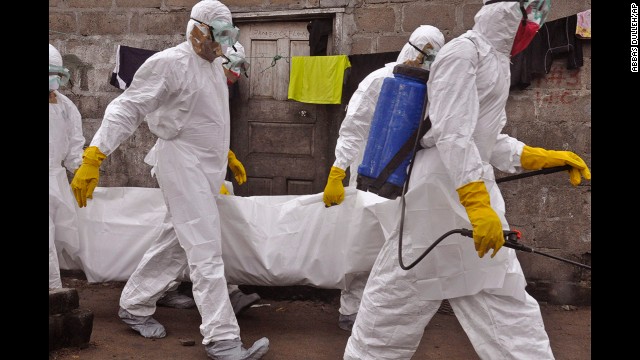 Health workers on Wednesday, September 10, carry the body of a woman who they suspect died from the Ebola virus in Monrovia, Liberia. Health officials say the current Ebola outbreak in West Africa is the deadliest ever. More than 4,200 cases have been reported since December, with more than 2,200 of them ending in fatalities, according to the World Health Organization.
Health workers on Wednesday, September 10, carry the body of a woman who they suspect died from the Ebola virus in Monrovia, Liberia. Health officials say the current Ebola outbreak in West Africa is the deadliest ever. More than 4,200 cases have been reported since December, with more than 2,200 of them ending in fatalities, according to the World Health Organization. 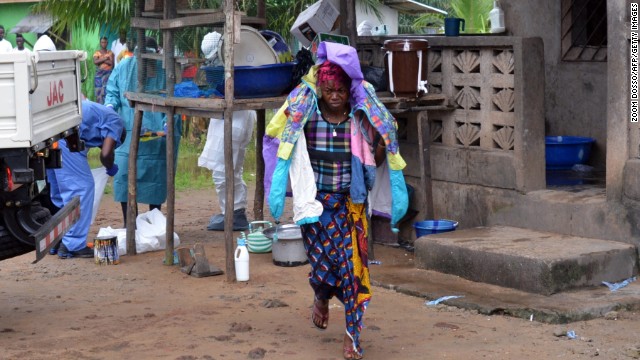 A woman in Monrovia carries the belongings of her husband, who died after he was infected by the Ebola virus.
A woman in Monrovia carries the belongings of her husband, who died after he was infected by the Ebola virus.  Five ambulances that were donated by the United States to help combat the Ebola virus are lined up in Freetown, Sierra Leone, on September 10 following a ceremony that was attended by Sierra Leone President Ernest Bai Koroma.
Five ambulances that were donated by the United States to help combat the Ebola virus are lined up in Freetown, Sierra Leone, on September 10 following a ceremony that was attended by Sierra Leone President Ernest Bai Koroma. 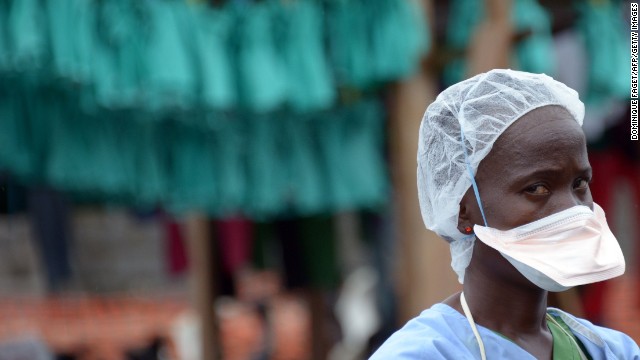 A health worker wears protective gear Sunday, September 7, at ELWA Hospital in Monrovia.
A health worker wears protective gear Sunday, September 7, at ELWA Hospital in Monrovia. 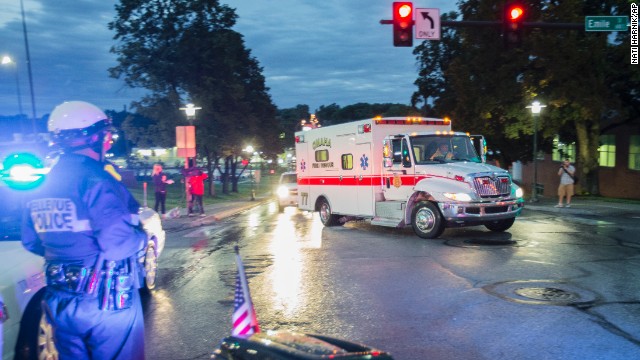 An ambulance transporting Dr. Rick Sacra, an American missionary who was infected with Ebola in Liberia, arrives at the Nebraska Medical Center in Omaha, Nebraska, on Friday, September 5. Sacra was being treated in the hospital's special isolation unit.
An ambulance transporting Dr. Rick Sacra, an American missionary who was infected with Ebola in Liberia, arrives at the Nebraska Medical Center in Omaha, Nebraska, on Friday, September 5. Sacra was being treated in the hospital's special isolation unit.  Medical workers from the Liberian Red Cross carry the body of an Ebola victim Thursday, September 4, in Banjol, Liberia.
Medical workers from the Liberian Red Cross carry the body of an Ebola victim Thursday, September 4, in Banjol, Liberia.  Health workers in Monrovia place a corpse into a body bag on September 4.
Health workers in Monrovia place a corpse into a body bag on September 4.  A rally against the Ebola virus is held in Abidjan, Ivory Coast, on September 4.
A rally against the Ebola virus is held in Abidjan, Ivory Coast, on September 4.  After an Ebola case was confirmed in Senegal, people load cars with household items as they prepare to cross into Guinea from the border town of Diaobe, Senegal, on Wednesday, September 3. Senegal has since closed its borders.
After an Ebola case was confirmed in Senegal, people load cars with household items as they prepare to cross into Guinea from the border town of Diaobe, Senegal, on Wednesday, September 3. Senegal has since closed its borders.  Crowds cheer and celebrate in the streets Saturday, August 30, after Liberian authorities reopened the West Point slum in Monrovia. The military had been enforcing a quarantine on West Point, fearing a spread of the Ebola virus.
Crowds cheer and celebrate in the streets Saturday, August 30, after Liberian authorities reopened the West Point slum in Monrovia. The military had been enforcing a quarantine on West Point, fearing a spread of the Ebola virus. 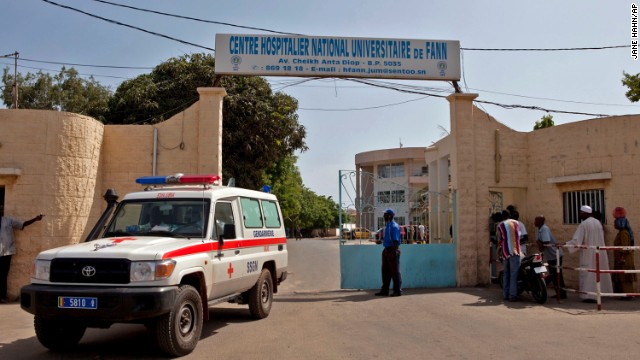 A ambulance leaves the University Hospital Fann in Dakar, Senegal, were a man was being treated for symptoms of the Ebola virus on Friday, August 29.
A ambulance leaves the University Hospital Fann in Dakar, Senegal, were a man was being treated for symptoms of the Ebola virus on Friday, August 29. 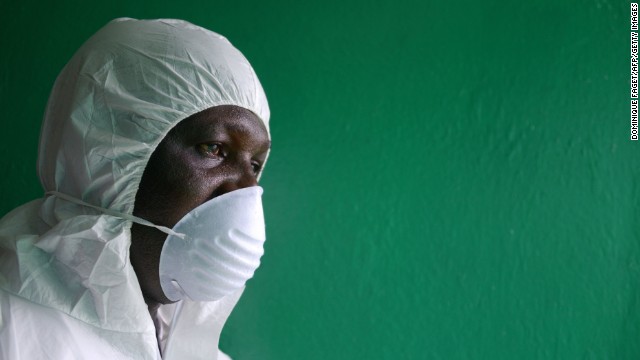 A health worker wearing a protective suit conducts an Ebola prevention drill at the port in Monrovia on August 29.
A health worker wearing a protective suit conducts an Ebola prevention drill at the port in Monrovia on August 29.  Senegalese Health Minister Awa Marie Coll-Seck gives a news conference August 29 to confirm the first case of Ebola in Senegal. She announced that a young Guinean had tested positive for the deadly virus.
Senegalese Health Minister Awa Marie Coll-Seck gives a news conference August 29 to confirm the first case of Ebola in Senegal. She announced that a young Guinean had tested positive for the deadly virus.  Volunteers working with the bodies of Ebola victims in Kenema, Sierra Leone, sterilize their uniforms on Sunday, August 24.
Volunteers working with the bodies of Ebola victims in Kenema, Sierra Leone, sterilize their uniforms on Sunday, August 24.  A Liberian health worker checks people for symptoms of Ebola at a checkpoint near the international airport in Dolo Town, Liberia, on August 24.
A Liberian health worker checks people for symptoms of Ebola at a checkpoint near the international airport in Dolo Town, Liberia, on August 24.  A guard stands at a checkpoint Saturday, August 23, between the quarantined cities of Kenema and Kailahun in Sierra Leone.
A guard stands at a checkpoint Saturday, August 23, between the quarantined cities of Kenema and Kailahun in Sierra Leone.  A burial team from the Liberian Ministry of Health unloads bodies of Ebola victims onto a funeral pyre at a crematorium in Marshall, Liberia, on Friday, August 22.
A burial team from the Liberian Ministry of Health unloads bodies of Ebola victims onto a funeral pyre at a crematorium in Marshall, Liberia, on Friday, August 22.  A humanitarian group worker, right, throws water in a small bag to West Point residents behind the fence of a holding area on August 22. Residents of the quarantined Monrovia slum were waiting for a second consignment of food from the Liberian government.
A humanitarian group worker, right, throws water in a small bag to West Point residents behind the fence of a holding area on August 22. Residents of the quarantined Monrovia slum were waiting for a second consignment of food from the Liberian government.  Dr. Kent Brantly leaves Emory University Hospital on Thursday, August 21, after being declared no longer infectious from the Ebola virus. Brantly was one of two American missionaries brought to Emory for treatment of the deadly virus.
Dr. Kent Brantly leaves Emory University Hospital on Thursday, August 21, after being declared no longer infectious from the Ebola virus. Brantly was one of two American missionaries brought to Emory for treatment of the deadly virus.  Brantly, right, hugs a member of the Emory University Hospital staff after being released from treatment in Atlanta.
Brantly, right, hugs a member of the Emory University Hospital staff after being released from treatment in Atlanta.  Family members of West Point district commissioner Miata Flowers flee the slum in Monrovia while being escorted by the Ebola Task Force on Wednesday, August 20.
Family members of West Point district commissioner Miata Flowers flee the slum in Monrovia while being escorted by the Ebola Task Force on Wednesday, August 20.  An Ebola Task Force soldier beats a local resident while enforcing a quarantine on the West Point slum on August 20.
An Ebola Task Force soldier beats a local resident while enforcing a quarantine on the West Point slum on August 20.  Local residents gather around a very sick Saah Exco, 10, in a back alley of the West Point slum on Tuesday, August 19. The boy was one of the patients that was pulled out of a holding center for suspected Ebola patients after the facility was overrun and closed by a mob on August 16. A local clinic then refused to treat Saah, according to residents, because of the danger of infection. Although he was never tested for Ebola, Saah's mother and brother died in the holding center.
Local residents gather around a very sick Saah Exco, 10, in a back alley of the West Point slum on Tuesday, August 19. The boy was one of the patients that was pulled out of a holding center for suspected Ebola patients after the facility was overrun and closed by a mob on August 16. A local clinic then refused to treat Saah, according to residents, because of the danger of infection. Although he was never tested for Ebola, Saah's mother and brother died in the holding center.  A burial team wearing protective clothing retrieves the body of a 60-year-old Ebola victim from his home near Monrovia on Sunday, August 17.
A burial team wearing protective clothing retrieves the body of a 60-year-old Ebola victim from his home near Monrovia on Sunday, August 17.  lija Siafa, 6, stands in the rain with his 10-year-old sister, Josephine, while waiting outside Doctors Without Borders' Ebola treatment center in Monrovia on August 17. The newly built facility will initially have 120 beds, making it the largest-ever facility for Ebola treatment and isolation.
lija Siafa, 6, stands in the rain with his 10-year-old sister, Josephine, while waiting outside Doctors Without Borders' Ebola treatment center in Monrovia on August 17. The newly built facility will initially have 120 beds, making it the largest-ever facility for Ebola treatment and isolation.  Brett Adamson, a staff member from Doctors Without Borders, hands out water to sick Liberians hoping to enter the new Ebola treatment center on August 17.
Brett Adamson, a staff member from Doctors Without Borders, hands out water to sick Liberians hoping to enter the new Ebola treatment center on August 17.  Workers prepare the new Ebola treatment center on August 17.
Workers prepare the new Ebola treatment center on August 17.  A body, reportedly a victim of Ebola, lies on a street corner in Monrovia on Saturday, August 16.
A body, reportedly a victim of Ebola, lies on a street corner in Monrovia on Saturday, August 16.  Liberian police depart after firing shots in the air while trying to protect an Ebola burial team in the West Point slum of Monrovia on August 16. A crowd of several hundred local residents reportedly drove away the burial team and their police escort. The mob then forced open an Ebola isolation ward and took patients out, saying the Ebola epidemic is a hoax.
Liberian police depart after firing shots in the air while trying to protect an Ebola burial team in the West Point slum of Monrovia on August 16. A crowd of several hundred local residents reportedly drove away the burial team and their police escort. The mob then forced open an Ebola isolation ward and took patients out, saying the Ebola epidemic is a hoax.  A crowd enters the grounds of an Ebola isolation center in the West Point slum on August 16. The mob was reportedly shouting, "No Ebola in West Point."
A crowd enters the grounds of an Ebola isolation center in the West Point slum on August 16. The mob was reportedly shouting, "No Ebola in West Point."  A health worker disinfects a corpse after a man died in a classroom being used as an Ebola isolation ward Friday, August 15, in Monrovia.
A health worker disinfects a corpse after a man died in a classroom being used as an Ebola isolation ward Friday, August 15, in Monrovia.  A boy tries to prepare his father before they are taken to an Ebola isolation ward August 15 in Monrovia.
A boy tries to prepare his father before they are taken to an Ebola isolation ward August 15 in Monrovia.  Kenyan health officials take passengers' temperature as they arrive at the Jomo Kenyatta International Airport on Thursday, August 14, in Nairobi, Kenya.
Kenyan health officials take passengers' temperature as they arrive at the Jomo Kenyatta International Airport on Thursday, August 14, in Nairobi, Kenya.  A hearse carries the coffin of Spanish priest Miguel Pajares after he died at a Madrid hospital on Tuesday, August 12. Pajares, 75, contracted Ebola while he was working as a missionary in Liberia.
A hearse carries the coffin of Spanish priest Miguel Pajares after he died at a Madrid hospital on Tuesday, August 12. Pajares, 75, contracted Ebola while he was working as a missionary in Liberia.  A member of the Centers for Disease Control and Prevention leads a training session on Ebola infection control Monday, August 11, in Lagos, Nigeria.
A member of the Centers for Disease Control and Prevention leads a training session on Ebola infection control Monday, August 11, in Lagos, Nigeria.  Health workers in Kenema, Sierra Leone, screen people for the Ebola virus on Saturday, August 9, before they enter the Kenema Government Hospital.
Health workers in Kenema, Sierra Leone, screen people for the Ebola virus on Saturday, August 9, before they enter the Kenema Government Hospital.  A health worker at the Kenema Government Hospital carries equipment used to decontaminate clothing and equipment on August 9.
A health worker at the Kenema Government Hospital carries equipment used to decontaminate clothing and equipment on August 9.  Health care workers wear protective gear at the Kenema Government Hospital on August 9.
Health care workers wear protective gear at the Kenema Government Hospital on August 9.  Paramedics in protective suits move Pajares, the infected Spanish priest, at Carlos III Hospital in Madrid on Thursday, August 7. He died five days later.
Paramedics in protective suits move Pajares, the infected Spanish priest, at Carlos III Hospital in Madrid on Thursday, August 7. He died five days later.  Nurses carry the body of an Ebola victim from a house outside Monrovia on Wednesday, August 6.
Nurses carry the body of an Ebola victim from a house outside Monrovia on Wednesday, August 6.  A Nigerian health official wears protective gear August 6 at Murtala Muhammed International Airport in Lagos.
A Nigerian health official wears protective gear August 6 at Murtala Muhammed International Airport in Lagos. 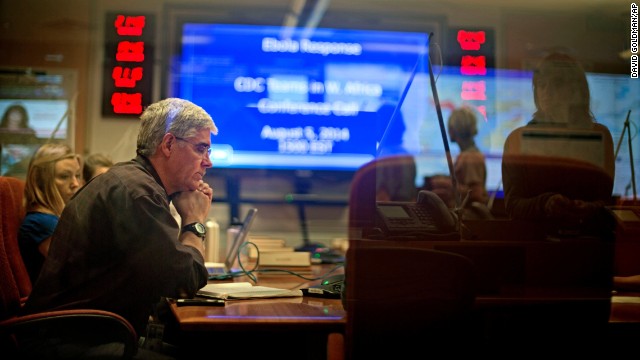 Officials with the Centers for Disease Control and Prevention in Atlanta sit in on a conference call about Ebola with CDC team members deployed in West Africa on Tuesday, August 5.
Officials with the Centers for Disease Control and Prevention in Atlanta sit in on a conference call about Ebola with CDC team members deployed in West Africa on Tuesday, August 5.  Aid worker Nancy Writebol, wearing a protective suit, gets wheeled on a gurney into Emory University Hospital in Atlanta on August 5. A medical plane flew Writebol from Liberia to the United States after she and her colleague Dr. Kent Brantly were infected with the Ebola virus in the West African country.
Aid worker Nancy Writebol, wearing a protective suit, gets wheeled on a gurney into Emory University Hospital in Atlanta on August 5. A medical plane flew Writebol from Liberia to the United States after she and her colleague Dr. Kent Brantly were infected with the Ebola virus in the West African country.  Nigerian health officials are on hand to screen passengers at Murtala Muhammed International Airport on Monday, August 4.
Nigerian health officials are on hand to screen passengers at Murtala Muhammed International Airport on Monday, August 4. 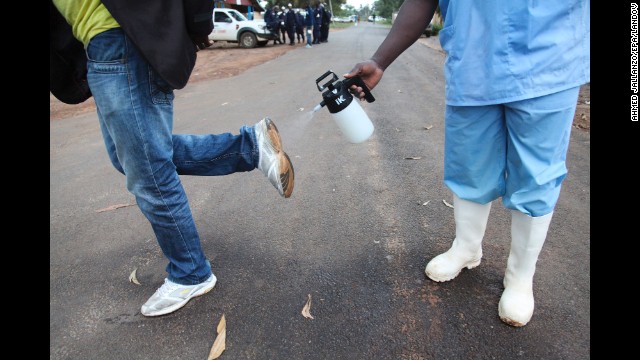 A man gets sprayed with disinfectant Sunday, August 3, in Monrovia.
A man gets sprayed with disinfectant Sunday, August 3, in Monrovia.  Dr. Kent Brantly, right, gets out of an ambulance after arriving at Emory University Hospital in Atlanta on Saturday, August 2. Brantly was infected with the Ebola virus in Africa, but he was brought back to the United States for further treatment.
Dr. Kent Brantly, right, gets out of an ambulance after arriving at Emory University Hospital in Atlanta on Saturday, August 2. Brantly was infected with the Ebola virus in Africa, but he was brought back to the United States for further treatment.  Nurses wearing protective clothing are sprayed with disinfectant Friday, August 1, in Monrovia after they prepared the bodies of Ebola victims for burial.
Nurses wearing protective clothing are sprayed with disinfectant Friday, August 1, in Monrovia after they prepared the bodies of Ebola victims for burial.  A nurse disinfects the waiting area at the ELWA Hospital in Monrovia on Monday, July 28.
A nurse disinfects the waiting area at the ELWA Hospital in Monrovia on Monday, July 28.  Liberian President Ellen Johnson Sirleaf, right, walks past an Ebola awareness poster in downtown Monrovia as Liberia marked the 167th anniversary of its independence Saturday, July 26. The Liberian government dedicated the anniversary to fighting the deadly disease.
Liberian President Ellen Johnson Sirleaf, right, walks past an Ebola awareness poster in downtown Monrovia as Liberia marked the 167th anniversary of its independence Saturday, July 26. The Liberian government dedicated the anniversary to fighting the deadly disease.  In this photo provided by Samaritan's Purse, Dr. Kent Brantly, left, treats an Ebola patient in Monrovia. On July 26, the North Carolina-based group said Brantly tested positive for the disease. Days later, Brantly arrived in Georgia to be treated at an Atlanta hospital, becoming the first Ebola patient to knowingly be treated in the United States.
In this photo provided by Samaritan's Purse, Dr. Kent Brantly, left, treats an Ebola patient in Monrovia. On July 26, the North Carolina-based group said Brantly tested positive for the disease. Days later, Brantly arrived in Georgia to be treated at an Atlanta hospital, becoming the first Ebola patient to knowingly be treated in the United States.  A 10-year-old boy whose mother was killed by the Ebola virus walks with a doctor from the aid organization Samaritan's Purse after being taken out of quarantine Thursday, July 24, in Monrovia.
A 10-year-old boy whose mother was killed by the Ebola virus walks with a doctor from the aid organization Samaritan's Purse after being taken out of quarantine Thursday, July 24, in Monrovia. 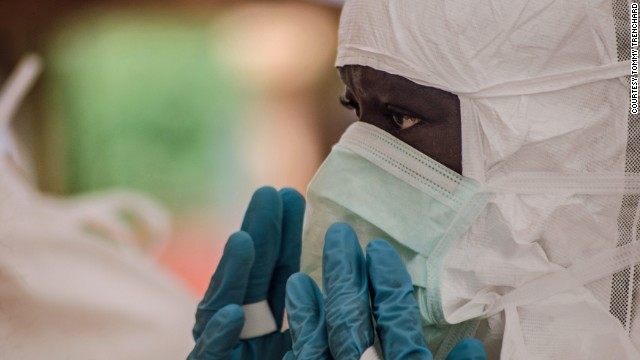 A doctor puts on protective gear at the treatment center in Kailahun, Sierra Leone, on Sunday, July 20.
A doctor puts on protective gear at the treatment center in Kailahun, Sierra Leone, on Sunday, July 20.  Members of Doctors Without Borders adjust tents in the isolation area in Kailahun on July 20.
Members of Doctors Without Borders adjust tents in the isolation area in Kailahun on July 20.  Boots dry in the Ebola treatment center in Kailahun on July 20.
Boots dry in the Ebola treatment center in Kailahun on July 20.  Red Cross volunteers prepare to enter a house where an Ebola victim died in Pendembu, Sierra Leone, on Friday, July 18.
Red Cross volunteers prepare to enter a house where an Ebola victim died in Pendembu, Sierra Leone, on Friday, July 18.  Dr. Jose Rovira of the World Health Organization takes a swab from a suspected Ebola victim in Pendembu on July 18.
Dr. Jose Rovira of the World Health Organization takes a swab from a suspected Ebola victim in Pendembu on July 18.  Red Cross volunteers disinfect each other with chlorine after removing the body of an Ebola victim from a house in Pendembu on July 18.
Red Cross volunteers disinfect each other with chlorine after removing the body of an Ebola victim from a house in Pendembu on July 18.  A dressing assistant prepares a Doctors Without Borders member before entering an isolation ward Thursday, July 17, in Kailahun.
A dressing assistant prepares a Doctors Without Borders member before entering an isolation ward Thursday, July 17, in Kailahun.  A doctor works in the field laboratory at the Ebola treatment center in Kailahun on July 17.
A doctor works in the field laboratory at the Ebola treatment center in Kailahun on July 17.  Doctors Without Borders staff prepare to enter the isolation ward at an Ebola treatment center in Kailahun on July 17.
Doctors Without Borders staff prepare to enter the isolation ward at an Ebola treatment center in Kailahun on July 17.  A health worker with disinfectant spray walks down a street outside the government hospital in Kenema on Thursday, July 10.
A health worker with disinfectant spray walks down a street outside the government hospital in Kenema on Thursday, July 10.  Dr. Mohamed Vandi of the Kenema Government Hospital trains community volunteers who will aim to educate people about Ebola in Sierra Leone.
Dr. Mohamed Vandi of the Kenema Government Hospital trains community volunteers who will aim to educate people about Ebola in Sierra Leone.  Police block a road outside Kenema to stop motorists for a body temperature check on Wednesday, July 9.
Police block a road outside Kenema to stop motorists for a body temperature check on Wednesday, July 9.  A woman has her temperature taken at a screening checkpoint on the road out of Kenema on July 9.
A woman has her temperature taken at a screening checkpoint on the road out of Kenema on July 9.  A member of Doctors Without Borders puts on protective gear at the isolation ward of the Donka Hospital in Conakry, Guinea, on Saturday, June 28.
A member of Doctors Without Borders puts on protective gear at the isolation ward of the Donka Hospital in Conakry, Guinea, on Saturday, June 28.  Airport employees check passengers in Conakry before they leave the country on Thursday, April 10.
Airport employees check passengers in Conakry before they leave the country on Thursday, April 10.  CNN's Dr. Sanjay Gupta, left, works in the World Health Organization's mobile lab in Conakry. Gupta traveled to Guinea in April to report on the deadly virus.
CNN's Dr. Sanjay Gupta, left, works in the World Health Organization's mobile lab in Conakry. Gupta traveled to Guinea in April to report on the deadly virus.  A Guinea-Bissau customs official watches arrivals from Conakry on Tuesday, April 8.
A Guinea-Bissau customs official watches arrivals from Conakry on Tuesday, April 8.  Egidia Almeida, a nurse in Guinea-Bissau, scans a Guinean citizen coming from Conakry on April 8.
Egidia Almeida, a nurse in Guinea-Bissau, scans a Guinean citizen coming from Conakry on April 8.  A scientist separates blood cells from plasma cells to isolate any Ebola RNA and test for the virus Thursday, April 3, at the European Mobile Laboratory in Gueckedou, Guinea.
A scientist separates blood cells from plasma cells to isolate any Ebola RNA and test for the virus Thursday, April 3, at the European Mobile Laboratory in Gueckedou, Guinea.  Members of Doctors Without Borders carry a dead body in Gueckedou on Friday, April 1.
Members of Doctors Without Borders carry a dead body in Gueckedou on Friday, April 1.  Gloves and boots used by medical personnel dry in the sun April 1 outside a center for Ebola victims in Gueckedou.
Gloves and boots used by medical personnel dry in the sun April 1 outside a center for Ebola victims in Gueckedou. 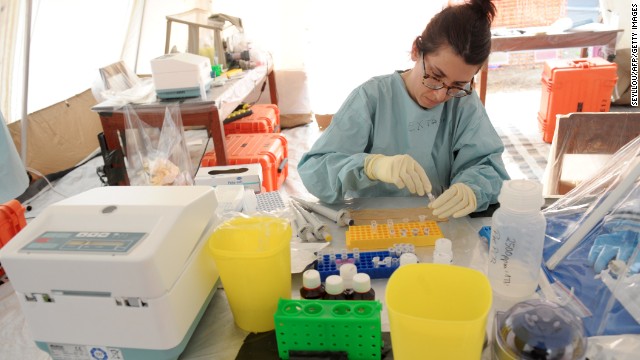 A health specialist works Monday, March 31, in a tent laboratory set up at a Doctors Without Borders facility in southern Guinea.
A health specialist works Monday, March 31, in a tent laboratory set up at a Doctors Without Borders facility in southern Guinea. 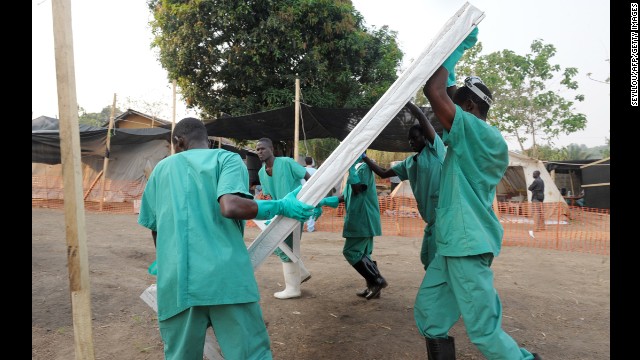 Health specialists work March 31 at an isolation ward for patients at the facility in southern Guinea.
Health specialists work March 31 at an isolation ward for patients at the facility in southern Guinea.  Workers associated with Doctors Without Borders prepare isolation and treatment areas Friday, March 28, in Guinea.
Workers associated with Doctors Without Borders prepare isolation and treatment areas Friday, March 28, in Guinea.  Photos: Ebola outbreak in West Africa
Photos: Ebola outbreak in West Africa And health care workers have very little to offer people as an incentive to cooperate.
"With smallpox, we could offer people a vaccine, a carrot in essence to induce them to be cooperative. With Ebola, we have nothing," Thea said.
In Sierra Leone, Levine, an officer with the Epidemic Intelligence Service at the Centers for Disease Control and Prevention, remembers the words of her agency's director, Dr. Tom Frieden. Battling Ebola is like fighting a forest fire: Miss even just one contact, and you could be leaving behind a burning ember that will reignite the outbreak.
When Levine arrived in Sierra Leone on August 17, she brought software on a thumb drive to manage cases and contacts. The software was designed by the CDC and was far more effective at organizing thousands of names than the unwieldy Excel spreadsheet that the local health care workers had been using.
With the help of other organizations, she also got the workers more computers and training in how to do contact tracing. Now, hundreds of contact tracers are assigned to go out into the neighborhoods in her district every day.
She says the death and illness all around her spur her on.
"Each one of these heartbreaking stories just makes me want to cry," she said. "It's more reason to try harder and think of more creative solutions."
No comments:
Post a Comment